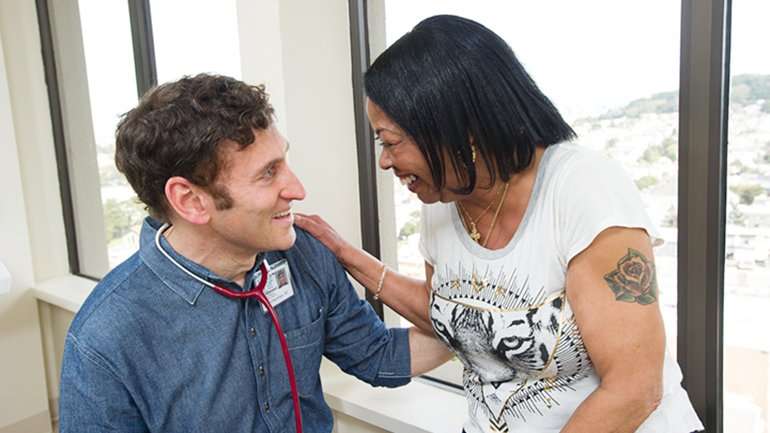Addressing trauma as a health risk

Questions about smoking, seat belts or regular exercise are routine at a doctor's office, thanks to the overwhelming data showing that the lives we lead influence our overall health. But one insidious yet common risk factor is rarely addressed: living with trauma.
From childhood abuse to poverty and racism, this threat takes many forms. As studies increasingly show, all have a staggering impact on a person's health.
When Edward Machtinger, MD, director of UCSF's Women's HIV Program, analyzed a decade of data from the program about why patients died, he found that only 16 percent of patients succumbed to HIV/AIDS infections. Nearly 84 percent of the deaths, however, were the result of trauma such as physical abuse, neglect, substance abuse or depression that resulted in suicide.
"We're providing extremely good care to women with HIV in terms of helping them achieve low levels of virus in their bodies," says Machtinger. "But half of our patients reported being depressed, and almost none were completely out about their HIV status, which meant that they didn't have a strong support system."
It's not just HIV. Trauma is a risk factor for most of the common diseases and risky health behaviors, such as smoking or substance abuse, that we address in health care, says Leigh Kimberg, MD, a family medicine doctor at Zuckerberg San Francisco General Hospital and Trauma Center. Adverse experiences affect health through diverse biological pathways, leading individuals who have experienced trauma to be more vulnerable to injury and illness and more reluctant to seek health care.

With multipronged efforts that ripple through San Francisco's health care systems, Kimberg and Machtinger are taking on trauma as more than just a social issue.
Targeting Trauma in HIV Clinics
Clinicians, nurses and other health care professionals in primary care clinics are rarely trained to handle patients experiencing trauma, Machtinger says.
In a project implemented early this year, Machtinger, Kimberg and colleagues at the Women's HIV Clinic, which is affiliated with the AIDS Research Institute (ARI) at UCSF, are working to develop a practical model of care. The project includes Carol Dawson-Rose, RN, PhD, FAAN; Yvette Cuca, PhD, MPH; Martha Shumway, PhD; Beth Chiarelli, MSW; and Naina Khanna.
The team began by working with UCSF's Trauma Recovery Center to simply observe how the clinic handled various processes and the flow of patients. Now, they plan to implement interventions and educate providers on how to better recognize and support patients experiencing trauma, as well as help providers cope with the psychological impacts of caring for such individuals.
With new grants from the Robert Wood Johnson Foundation and others, the clinic will be among the first in the nation to "implement and evaluate a holistic model of trauma-informed primary care," says Machtinger.
While this project works at the clinic level to address the myriad forms of trauma that an HIV patient might experience, Kimberg, in partnership with Dean Schillinger, MD, Eliza H. Bakken, MD, and Machtinger, has received a federal grant to formalize a larger collaborative that aims to address trauma – specifically intimate-partner violence, sexual assault and reproductive coercion – across an entire health care system.
Making Systemwide Changes
Kimberg was only a medical student when she first met a patient who appeared to have suffered abuse. But the experience of asking a patient about their experiences with trauma – and figuring out how best to respond in the clinic – has shaped her career since.
Kimberg and her colleagues have designed a study to address interpersonal violence (IPV) in the primary care and women's clinics of the San Francisco Health Network. All patients will be offered education, screening and counseling for IPV. Patients in some of the clinics will be offered immediate on-site help by a domestic-violence advocate, and patients suffering from a high burden of trauma will be assisted by the UCSF Trauma Recovery Center. The study will measure many different outcomes to assess which of these interventions are the most effective.
"There's evidence that screening patients for this trauma and planning safety interventions in the primary-care clinic is both safe and effective," says Kimberg. "In some cases, it's also effective at reducing the incidence of intimate partner violence."
Now, Kimberg focuses on translating the individual experiences of clinicians, including herself, into policies that can benefit providers and patients alike. She has helped implement a citywide policy in San Francisco that requires all San Francisco Department of Public Health primary care clinics to screen for intimate-partner violence, and has created the LEAPSF website, which gives providers a safety plan on how to intervene appropriately for patients experiencing such trauma.
To Kimberg and Machtinger, the benefits of addressing trauma in the clinic are many. Tackling trauma head-on can cut patients' risk of physical harm – and just as importantly, provide support for healthy habits that help them avoid conditions such as heart disease, diabetes or mental illness, says Machtinger.
"Health systems are moving toward preventive care, where instead of being funded for hospitalizations and procedures, we are funded to keep people healthy and avoid these procedures," he says. "For us, trauma-informed care is the single most promising way to do that."
















